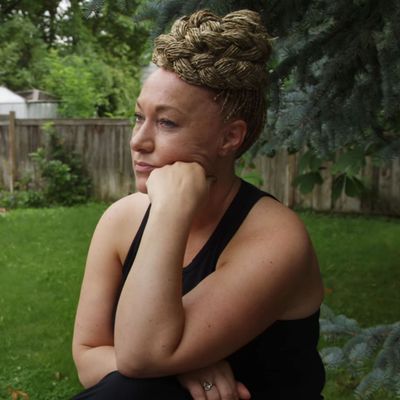
As a nation we agree on little, but in 2015 we somehow all agreed on the subject of Laura Brownson’s intimate documentary, The Rachel Divide: Rachel Dolezal, the brick-colored, dreadlocked black woman who became the head of the Spokane, Washington, branch of the NAACP — until a reporter discovered that she was, in fact, as black as Pippi Longstocking. The right saw her as the ultimate snowflake-poseur, so oversensitized by racism that she was driven to enact the role of victim. The left turned away in embarrassment. Blacks saw her attempt to join their ranks as a reductio ad absurdum of “white privilege”: It makes all the difference in the world, they said, when you choose to endure racism. Just about everyone was aghast by her defiant assertion, “Race is a construct.” And no one didn’t think she was nucking futs.
Brownson’s fine, nuanced documentary suggests another way of framing the life of Dolezal, one that includes the requisite ridicule but manages to elicit a finite but genuine sympathy. The Rachel Divide plays like a would-be superhero “origin story.” I’m not being facetious when I liken her to Bruce Wayne, who had a profound trauma and adopted the persona of a bat to express both his melancholy and anger against injustice. Dolezal adopted another sort of black costume and went to the front lines of different kind of war against injustice.
Much of Dolezal’s past has been recounted in newspapers and magazines and in an autobiography that no one (including me) has read. But with careful editing, Brownson puts Dolezal’s past struggles in the present tense. Her parents were religious fanatics who adopted four black children and, according to Dolezal, “raised them to be white.” Those children were beaten. (One, Isaiah, displays the scars on his back.) Another was allegedly sexually assaulted by Dolezal’s white brother. It seems that Dolezal empathized so powerfully with her stepsiblings’ pain that she immersed herself in black culture in an attempt to help them come to terms with their true racial identities. “I felt I could bridge the divide,” she says.
I don’t know about you, but to me that’s commendable. The trouble began with that “race is a construct” thing, a complicated idea that’s worth mulling over for a minute or two before laughing off. The masquerade might still be in place if Dolezal hadn’t gone, as they say, a bridge too far. After she led vocal protests against police, racist hate mail and death threats began appearing in her organization’s P.O. box. Spokane and its environs is undoubtedly home to fervent white-supremacy groups, but the letters didn’t pass the smell test. (They appeared not even to have been posted.) Reporters — some interviewed onscreen — began digging, which led to a TV sandbagging watched by millions: “Are you African-American?” “I don’t understand the question.”
Wrong answer.
Brownson talks to some of Dolezal’s fiercest critics, among them her former NAACP colleague Kitana Johnson. Nothing they say about her strikes me as wrongheaded. A tentative defense — that Dolezal can be likened to Caitlyn Jenner and others who have rejected their so-called birth genders — is appropriately shouted down. No, no one has much good to say about Rachel Dolezal.
It’s the scale of the abuse — especially from Twitter — that comes to seem insane. I mean, Henry Kissinger is kissed up to by presidents. Paul Wolfowitz still holds an important job. Why would someone watch Dolezal on the Today — on which the interviewer displays earnest condescension, as if talking to a small child — and tweet, “I wouldn’t piss on her if her shoes were on fire”? I know it’s Twitter but really? You wish her dead? Dolezal is photographed touring Howard University with her son, a high-school senior who is black, and thousands bombard Howard with calls to reject the innocent boy’s application and go on to wish the worst for him. Holed up in her house with her palpably miserable (but apparently well-loved) children; unable to find work (she was paid a pittance for her book, which sold several hundred copies); and watching the rape case against her white brother fail because of her — not the actual victim’s — credibility, she is devastated. Her older son drives away, beaten down by all the hate and upset with how she “put herself out there.” But still Dolezal insists that she’s black, mostly.
Early in The Rachel Divide, a commentator describes Dolezal as a Rorschach blot, and the movie is one, too. Some people think it’s a hatchet job, others that it gives its subject’s commitment to social justice too much credence. I found it pretty much down the middle, meaning Brownson has done doing exactly what she needed to: show how Dolezal was formed, how society responded to her insistence that “race is a construct,” and how she’s coping in the face of such relentless hatred.
One other thing the movie shows: Dolezal is a gifted painter and collagist. But I imagine that her Afrocentric palette will be viewed, along with everything else in her life, as cultural appropriation. This white male disagrees with much of what she says but still feels for her.


